When considering the potential trajectory of XRP in 2025, one must evaluate various indicators such as market adoption, regulatory developments, and technological innovations in the blockchain space. There is optimism around XRP’s future, primarily due to its collaborations with financial institutions and its commitment to facilitating cross-border transactions efficiently. Some analysts predict that if favorable conditions persist, XRP could experience significant price appreciation by 2025.
It’s important to keep in mind the volatility inherent in cryptocurrency markets. While optimistic predictions prevail, investment in digital assets comes with notable risks. This uncertainty highlights the necessity for investors to stay well-informed and cautious when making financial decisions related to XRP.
Regulatory scrutiny continues to be a defining factor in XRPs evolution. With ongoing legal discussions, especially concerning Ripple Labs, the outcome could considerably influence market sentiment and determine XRP’s position in the cryptocurrency landscape by 2025. Understanding these dynamics can provide a comprehensive outlook for readers interested in the future of XRP.
XRP Overview
XRP has had a notable trajectory in the cryptocurrency landscape. It leverages the power of its cutting-edge technology and the strategic moves by Ripple, the company behind it. This overview delves into critical aspects of XRP’s historical performance and future potential.
Historical Performance
Since its inception, XRP has demonstrated significant fluctuations in value. Initially launched in 2012, its price gained momentum during the crypto boom of late 2017, reaching an all-time high near $3.84 in January 2018. This period marked XRP as one of the top cryptocurrencies in terms of market capitalization.
The price has since seen considerable swings, influenced by broader market trends and regulatory developments. XRP experienced a substantial drop during the bear market that followed the 2017 peak. Despite this, it has maintained a strong presence within the top cryptocurrencies and continues to attract investor interest and speculation.
XRP Technology and Infrastructure
XRP relies on the XRP Ledger (XRPL), a decentralized, open-source blockchain ledger. Unlike Bitcoin, it uses a unique consensus algorithm known as the Ripple Protocol Consensus Algorithm (RPCA), which allows faster and more energy-efficient transactions.
Transactions on the XRPL are finalized in 3-5 seconds, with fees often below $0.01. This efficiency makes XRP suitable for cross-border transactions, a crucial use case emphasized by Ripple. Additionally, the XRPL supports various features like decentralized exchanges and custom token issuance, offering flexibility and utility beyond typical cryptocurrency applications.
Ripple Company Developments
Ripple, the company behind XRP, plays a pivotal role in its adoption and innovation. Known for its partnerships with financial institutions, Ripple aims to facilitate faster and cheaper international payments. Initiatives like RippleNet offer a suite of products that leverage XRP for liquidity and cross-border transaction settlement.
Legal challenges, particularly the ongoing lawsuit with the U.S. Securities and Exchange Commission (SEC), have impacted XRP’s regulatory outlook and price movements. Despite these challenges, Ripple continues to focus on expanding its global reach and developing its technology offerings. Recent expansions into new markets and partnerships demonstrate its ambition to strengthen XRP’s position in the global financial ecosystem.
Current Market Analysis
XRP’s market landscape is influenced by several factors such as regulatory considerations, competitive forces, and strategic alliances. These aspects drive market sentiment and potential.
Regulatory Environment
The regulatory landscape affects XRP significantly due to ongoing legal challenges and policy changes. The Securities and Exchange Commission (SEC) lawsuit against Ripple, the entity closely associated with XRP, remains pivotal. The outcome could influence XRP’s classification as a security or currency.
Different countries exhibit varying stances, with some adopting more lenient frameworks. Jurisdictions like Japan have accepted XRP with favorable regulations, while others remain cautious. Central bank digital currencies (CBDCs) and evolving cryptocurrency regulations closely tie into XRP’s market dynamics.
Competitor Landscape
XRP operates in a competitive digital currency market with key players such as Bitcoin, Ethereum, and emerging alternative coins. Ethereum’s advancements in smart contract technology pose a substantial challenge, given their growing adoption.
Financial institutions exploring blockchain technology also impact XRP. Companies like Stellar present alternative solutions for cross-border payments, directly competing in XRP’s niche. Competition drives innovation and adoption strategies.
An analysis of market capitalization trends shows XRP fluctuating but maintaining a prominent position within the top cryptocurrencies. The entry of new competitors and technological changes continues to impact XRP’s market position.
Adoption and Partnerships
XRP’s real-world applications hinge on the adoption by financial institutions and strategic partnerships. Ripple’s collaborations with banks and payment providers bolster XRP’s use case for cross-border transactions. Partnerships with major entities such as Santander and American Express highlight its utilization.
RippleNet, facilitating global payments, strengthens XRP’s network, favoring widespread adoption. Greater collaboration with financial institutions could propel increased XRP transactions.
Adoption metrics, such as transaction volume and distribution among holders, indicate growing engagement. These partnerships and XRP’s ease of integration into existing systems contribute to increased potential use and market stability.
2025 Prediction Methodologies
Predicting XRP’s future value in 2025 requires multiple approaches. Key methodologies involve analyzing historical price trends, assessing intrinsic value factors, gauging market sentiment, and consulting financial experts.
Technical Analysis
Technical analysis involves examining past market data, primarily price and volume. Analysts use charts to identify trends and patterns that could point to future movements. Key indicators include moving averages, RSI (Relative Strength Index), and MACD (Moving Average Convergence Divergence).
Chart patterns like head-and-shoulders or triangles provide visual cues for potential price directions. Technical analysis assumes past price actions might predict future outcomes, making it a critical tool.
Fundamental Analysis
Fundamental analysis focuses on evaluating XRP’s intrinsic value. It includes examining the company’s financial health, utility, partnerships, and broader economic factors. For XRP, assessing Ripple’s ongoing legal battles and partnerships with financial institutions provides insight.
The analysis also considers supply factors and the impact of regulatory changes. By understanding these fundamentals, investors gain insights into possible price movements.
Sentiment Analysis
Sentiment analysis gauges public and investor emotions towards XRP using social media, forums, and news sentiment. Tools like AI and machine learning quantify sentiment, enabling analysts to predict potential price impacts.
This form of analysis considers news trends and tweets, which can drive market volatility. Positive or negative shifts in sentiment can significantly influence XRP’s market position.
Expert Opinions
Expert opinions provide a qualitative perspective on XRP’s potential trajectory. Financial analysts and cryptocurrency experts often share their forecasts based on thorough research and experience.
They may account for economic factors, industry trends, and technological advancements impacting XRP. Following expert interviews or published reports can offer valuable context for understanding possible future scenarios.
Potential Scenarios for 2025
In 2025, XRP might experience significant price changes. The market’s direction could hinge on regulatory developments, adoption rates, and partnerships.
Bullish Case
XRP might see rising demand and price if banks and financial institutions increase their use of Ripple’s technology for cross-border payments. Partnerships with large financial entities could bolster XRP’s legitimacy. Regulatory clarity could further enhance trust, prompting investors and institutions to invest heavily.
Technological advancements in the Ripple network could also play a role. Increased speed and reduced transaction costs would make Ripple’s technology more attractive. Adoption of CBDCs could also support XRP, especially if Ripple provides technological infrastructure. Together, these factors could drive a sustained bull run for XRP.
Bearish Case
The bearish scenario might unfold if XRP faces legal or regulatory setbacks, particularly in the United States. Ongoing legal challenges with the SEC could limit investment and adoption. Negative outcomes could reduce trust and result in reduced interest from institutional investors.
Furthermore, competition from newer or more technologically advanced cryptocurrencies could erode XRP’s market share. Banks might opt for other solutions, limiting Ripple’s growth. A broader economic downturn impacting the crypto sector could also weigh heavily on XRP prices, leading to prolonged bearish sentiment.
Stable Growth Scenario
In a situation of steady growth, XRP could see moderate gains through consistent partnerships and a stable regulatory environment. Incremental adoption by medium-sized financial institutions might ensure a gradual increase in usage. Technological upgrades could sustain interest without causing price spikes.
The crypto market’s maturity could offer stability, reducing volatileness. Continued education about Ripple’s offerings could promote a broader understanding and acceptance. A balanced supply and demand situation would maintain XRP’s market value, possibly leading to modest appreciation over time. Pricing might stabilize around consistent volumes and use cases.
Implications of 2025 Predictions
XRP’s projected trends for 2025 hold significant potential to alter investment strategies, reshape global remittance systems, and disrupt overall cryptocurrency market dynamics.
Impact on Investors
XRP’s future value has a direct influence on investor confidence and decision-making. Significant price increases could attract a larger investor base, potentially leading to increased market liquidity. With a stable or rising XRP value, long-term holders might experience enhanced portfolio growth.
Potential Risks: Price volatility remains a concern for investors, posing risks of sudden losses. Regulatory developments also play a crucial role, as changes in cryptocurrency regulations could affect XRP’s market standing.
Investment Strategy Adjustments: Investors might consider diversifying their portfolios to mitigate risk, perhaps incorporating other digital assets. Due diligence and monitoring of regulatory updates can be crucial for informed decision-making.
Influence on Global Remittances
As a prominent player in the remittance industry, XRP facilitates faster and cheaper cross-border transactions. An increase in XRP adoption could significantly lower transaction costs for international money transfers, especially benefiting migrant workers and businesses.
Efforts to integrate XRP in more financial institutions might enhance its utility, making it a preferred choice for remittances. Challenges include overcoming regulatory hurdles and gaining trust among traditional financial bodies.
The expansion of such adoption could accelerate financial inclusion, providing underbanked populations with easier access to global financial systems.
Effect on Cryptocurrency Markets
XRP’s trajectory has the potential to impact the broader cryptocurrency market. Substantial growth in its value could shift investor focus, drawing attention from other cryptocurrencies.
Market Perception: A positive performance may enhance XRP’s reputation, establishing it as a reliable digital asset. Conversely, any setbacks might influence market confidence.
Regulatory changes and technological advancements can reshape XRP’s market dynamics, affecting its pricing and adoption levels. Market Ecosystem Changes: Ripple’s partnerships and technological evolutions may lead to new use cases and applications within the crypto space.
Investment Strategies
Exploring different strategies for investing in XRP can help mitigate risks and maximize potential returns. From maintaining positions over extended periods to exploring dynamic trading tactics, investors can utilize various methods to align with their financial goals.
Long-Term Holding
Long-term holding involves maintaining an investment in XRP for an extended period, often several years. This strategy is based on the belief in the digital currency’s potential for growth over time. By focusing on the broader trajectory rather than short-term fluctuations, investors may benefit from significant value increases.
Patience and resilience are key to this approach, as the cryptocurrency market can be volatile. Employing a long-term perspective helps mitigate the impact of temporary market downturns, and it’s crucial to stay informed on developments that could influence XRP’s long-term value.
Active Trading Approaches
Active trading in XRP involves buying and selling based on market trends and price movements. This method requires frequent monitoring and analysis of market conditions. Traders often use technical analysis tools to identify entry and exit points to capitalize on short-term price changes.
Swing trading and day trading are popular active strategies. While swing trading capitalizes on longer-term trends, day trading focuses on intraday movements. Each approach demands discipline, knowledge, and the willingness to act quickly. Active traders must remain vigilant and adaptive to market changes and possess a robust understanding of market indicators and patterns.
Diversification Strategies
Diversification involves spreading investments across multiple assets to minimize risk. By including XRP alongside other cryptocurrencies, stocks, or bonds in a portfolio, investors can reduce the impact of a poor-performing asset. This strategy helps balance risk and reward, providing a safety net against volatility.
A diversified portfolio might include a mix of digital assets with varying market capitalizations and growth potential. This approach requires continuous review and adjustment to align with changing market conditions and personal investment goals. Including XRP as part of a broader investment plan can help stabilize returns and reduce dependence on the performance of a single asset.
Risks and Considerations
Exploring potential investment in XRP for 2025 requires awareness of several key risks. These include market volatility, legal challenges, and technological hurdles. Each aspect can significantly affect XRP’s value and investor confidence.
Market Volatility
The cryptocurrency market is known for its dramatic price swings. XRP is no exception, with its price often influenced by broader market trends. External factors such as economic events, regulatory news, or shifts in investor sentiment can cause rapid price changes. These fluctuations may present opportunities for gains but equally carry the risk of losses.
Investors must closely monitor market trends and news cycles. Tools like technical analysis and sentiment analysis can help manage this risk, but they do not guarantee predictive accuracy. Understanding risk tolerance and setting clear investment goals are crucial aspects of handling volatility.
Legal and Compliance Risks
Ripple, XRP’s parent company, has faced several legal challenges, most notably the ongoing lawsuit with the U.S. Securities and Exchange Commission (SEC). The outcome of this litigation could have significant repercussions. Regulatory changes in major markets also present potential compliance challenges.
Investors should stay updated on legal developments. Countries may alter their stance on cryptocurrency regulation, affecting XRP’s legality and market acceptance. It’s essential to conduct thorough due diligence on regulatory environments before investing.
Technology Risks
XRP relies on blockchain technology, which presents its own risks. Security vulnerabilities in the network could lead to breaches or losses. While XRP’s consensus mechanism is designed to be robust, no technology is immune to attacks.
Additionally, XRP must continuously innovate to remain competitive. Any failure in technological advancement can impact its network’s efficiency and scalability. Investors should keep an eye on technological updates and ensure that the platform’s development team addresses any potential vulnerabilities or inefficiencies effectively.
Conclusion
The journey of XRP in 2025 presents both opportunities and challenges. Market dynamics, regulatory developments, and technological advancements will shape its path.
Analysts foresee potential price fluctuations. Volatility remains a critical factor, influencing investment decisions. Investors should stay informed, considering both risks and opportunities.
Recent partnerships and expanding use cases could bolster XRP adoption. Real-world applications, such as cross-border payments, keep it relevant.
Regulatory clarity will be crucial. Monitoring legal frameworks and policy changes is essential for stakeholders.
Informed speculation may guide decision-making. Continuous research and analysis help understand market trends and future prospects for XRP.












